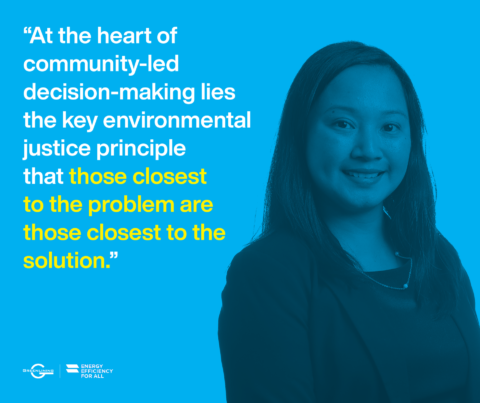 This post is part of our blog series, “Energy Optimization: It’s Time to Reimagine Energy Efficiency.”
This post is part of our blog series, “Energy Optimization: It’s Time to Reimagine Energy Efficiency.”
No effort to clean up our emissions can succeed unless it is pursued equitably. That means every process is inclusive from the very beginning. It means frontline and environmental justice communities not only have a seat at the table, but are leading strategies that will help provide a just and equitable transition and possess the agency to determine what is best for their communities.
California has embarked on a path toward achieving 100 percent carbon-free electricity by the year 2045 and dramatically reducing economy-wide emissions. Buildings account for a quarter of California’s greenhouse gas emissions, and millions of them need upgrades that reduce energy use. Electrifying the built environment and transitioning away from fossil fuels to heat and power our buildings is more energy efficient and less polluting, meeting a two-fold, larger vision to decrease emissions in the state and improve the health of our communities.
A new report released this month by the Greenlining Institute and the California Energy Efficiency for All (EEFA) coalition presents a five-step framework for electrifying California’s buildings while prioritizing environmental and social justice (ESJ) communities. Equitable Building Electrification: A Framework for Powering Resilient Communities proposes how to ensure that, as we electrify, the most vulnerable communities electrify first to protect them from a progressively more expensive fossil-fuel system.
ESJ communities—made up mostly of renters, predominantly people of color, and/or those living on limited incomes—largely have been left out of California’s push toward clean energy. Even as solar panels have proliferated on home rooftops over the past two decades, for example, the market penetration has been unacceptably lopsided. By the end of 2017, the total photovoltaic (PV) capacity per capita installed outside of disadvantaged communities is almost three times that installed inside of them, according to a recent study by EEFA partner PSE Healthy Energy, published in the journal Energy Policy. The $1billion Solar on Multifamily Affordable Housing (SOMAH) program ($100 million per year over 2019–2029), which our EEFA partners were instrumental in advancing, points to progress on changing these patterns and, given the level of investment needed, demonstrates we still have a long way to go.
 These same communities suffer higher-than-average financial energy and housing-cost burdens due to the widening wealth gap in the state and housing affordability crisis. Given our forward-thinking California requirements, the transition off of fossil fuels is inevitable. Greenlining’s report describes the risks if our ESJ communities once again benefit last, and are stuck paying disproportionately more and shouldering the cost of early adopters. Even in the near-term, the costs of maintaining California’s gas infrastructure are increasing rapidly, to the point where Southern California Gas and Pacific Gas & Electric have requested a 30 percent and 15 percent rate increase for their customers, respectively, between now and the year 2022.
These same communities suffer higher-than-average financial energy and housing-cost burdens due to the widening wealth gap in the state and housing affordability crisis. Given our forward-thinking California requirements, the transition off of fossil fuels is inevitable. Greenlining’s report describes the risks if our ESJ communities once again benefit last, and are stuck paying disproportionately more and shouldering the cost of early adopters. Even in the near-term, the costs of maintaining California’s gas infrastructure are increasing rapidly, to the point where Southern California Gas and Pacific Gas & Electric have requested a 30 percent and 15 percent rate increase for their customers, respectively, between now and the year 2022.
With gas system maintenance costs escalating and safety risks ever present, families need electrification today—not just for the utility bill savings, but also for cleaner indoor air, safer home environments, and well-paying local jobs in energy efficiency. Policies to help create comprehensive climate and health solutions must come from the impacted communities. Ensuring this requires building deep trust through relationships with frontline and community-based organizations. No single organization can produce real, lasting climate solutions. The Equitable Electrification Framework was initiated by bringing together housing rights, environmental justice, health, community-based, and environmental organizations from all over the state and providing resources to frontline groups to enable them to participate in the discussion.
Targeted funding to groups like Greenlining Institute; the California Environmental Justice Alliance, which is leading on a strategy around the future of gas infrastructure; and the Los Angeles Alliance for a New Economy for their work with labor and job opportunities for ESJ and their partners, is critical to ensuring that processes are community-led. EEFA’s work is not possible without groups like these and allies such as the Asian Pacific Environmental Network because of the trust and reach they have established within their communities. More funding is needed to build capacity to allow impacted communities to lead on strategy. Climate efforts frequently leave these organizations out of processes, or ask to bring them in at the last minute.
How are low-income programs leading on strategy? The Low-Income Weatherization Program (LIWP) is arguably the first comprehensive building-electrification program in the state. It combines energy efficiency with solar PV funding, allows for fuel switching, and has put millions of dollars toward electrification measures. By enabling air sealing, insulation, and comprehensive energy and health and safety improvements, LIWP helps families save energy, reduce electric bills, and improve the health and comfort of their homes. Programs like LIWP suffer from funding fluctuations that impact the ability to coordinate with other programs long-term to help get to deeper savings and program reach.
To address these and other barriers, the Equitable Building Electrification Framework recommends these steps:
Step 1: Assess the communities’ needs. This should include understanding the barriers preventing community members from electrifying their homes, residents’ knowledge levels regarding building electrification, and their specific needs, wishes, and concerns.
Step 2: Establish community-led decision-making. Rich community input and engagement strengthens the overall program design quality with stronger cultural competence, ensuring local buy-in and investment, and delivering tangible local benefits rooted in the lived experiences of everyday people. Partner with community-based organizations to develop a decision-making process that ensures that decisions are based on community needs and priorities.
Step 3: Develop metrics and a plan for tracking. Metrics should include both clean energy benefits, like greenhouse gas reductions, and community benefits such as local hiring requirements, and residents’ ability to pay their energy bills without sacrificing other essential expenses.
Step 4: Ensure funding and program leveraging. Current low-income energy programs often fail to deliver maximum benefits to all qualifying households due to short and unpredictable funding cycles, poor program design that inadequately reaches qualifying customers, or lack of coordination and integration with complementary programs.
Step 5: Improve outcomes. Using the tracking and metrics plan described in Step 3, ensure that there is a continuous feedback loop to improve current and future programs’ reach and impact in ESJ communities. Consider adjustments to ensure the program reaches the people it seeks to reach and delivers the intended benefits.
Investing in electrification of our housing infrastructure and other buildings is a tangible strategy that we can embark on today to help meet our long-term decarbonization goals. It also presents an opportunity to use investment in a clean economy to help close the inequality gap—if we center the conversation on who benefits from the transition and ensure that thoughtful, deliberate, and inclusive policy making leads to lasting solutions for all Californians, particularly our most vulnerable communities.